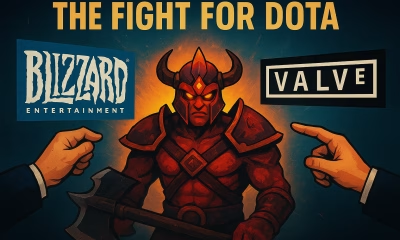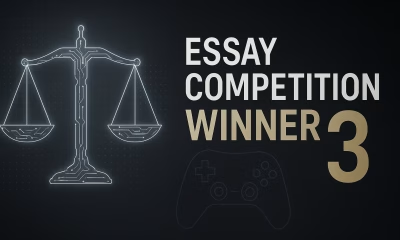IP
The Misuse of Arma 3 Footage in Disinformation Campaigns and IP Rights
In recent times, the world has witnessed the misuse of video game footage in the propagation of false information, especially during times of conflict. One such game that has been at the forefront of this controversy is Arma 3, developed by Bohemia Interactive. The game’s realistic graphics and modding capabilities have made it a prime target for those looking to spread disinformation.

Arma 3 and its Esports Footprint
Arma 3, developed by Bohemia Interactive, is not just a military simulation game known for its realistic graphics and extensive modding capabilities; it also boasts a small but active esports community. While it may not have the massive competitive scenes of other mainstream titles, Arma 3’s dedicated player base has organized various tournaments and events, showcasing the game’s strategic depth and team-based gameplay. This esports angle adds another dimension to Arma 3, highlighting its versatility and appeal to both casual gamers and competitive players.
In recent times, the world has witnessed the misuse of video game footage in the propagation of false information, especially during times of conflict. One such game that has been at the forefront of this controversy is Arma 3. The game’s realistic graphics and modding capabilities have made it a prime target for those looking to spread disinformation.
Arma 3 and the Israel-Hamas Conflict
The recent hostilities between Israel and Hamas have seen a surge in the misuse of Arma 3 footage. Clips from the game have been falsely presented as real-world news on social media platforms, leading to widespread confusion and misinformation. Addressing this issue, Bohemia Interactive released a statement urging players and content creators to “use their footage responsibly.” The developer’s plea aims to prevent the game’s clips from adding to the deluge of false information circulating online. The studio went a step further by providing a detailed guide to help the public differentiate between in-game videos and actual combat footage.
- Very low resolution – Even dated smartphones have the ability to provide videos in HD quality. Fake videos are usually of much lower quality, and are intentionally pixelated and blurry to hide the fact that they’re taken from a video game.
- Very low resolution – To add dramatic effect, these videos are often not captured in-game. Authors film a computer screen with the game running in low quality and with an exaggerated camera shake.
- Often takes place in the dark / at night – The footage is often dark in order to hide the video game scene’s insufficient level of detail.
- Mostly without sound – In-game sound effects are often distinguishable from reality.
- Doesn’t feature people in motion – While the game can simulate the movement of military vehicles relatively realistically, capturing natural looking humans in motion is still very difficult, even for the most modern of games.
- Heads Up Display (HUD) elements visible – Sometimes the game’s user interfaces, such as weapon selection, ammunition counters, vehicle status, in-game messages, etc. are visible. These commonly appear at the edges or in the corners of the footage.
- Unnatural particle effects – Even the most modern games have a problem with naturally depicting explosions, smoke, fire, and dust, as well as how they’re affected by environmental conditions. Look for oddly separated cloudlets in particular.
- Unrealistic vehicles, uniforms, equipment – People with advanced military equipment knowledge can recognize the use of unrealistic military assets for a given conflict. For instance, in one widely spread fake video, the US air defense system C-RAM shoots down a US A-10 ground attack plane. Units can also display non-authentic insignias, camouflage, etc.
Bohemia Interactive also expressed their distress on Twitter, stating,
“It’s disheartening for us to see the game we all love being used in this way.”
They acknowledged their collaboration with fact-checking agencies to address the issue but admitted that it’s impossible to eliminate the problem entirely.
A Recurring Problem
The misuse of Arma 3 footage is not a new phenomenon. In the past, clips from the game were falsely presented as evidence of the Russian invasion of Ukraine in 2022. Similarly, in 2021, an Indian news channel mistakenly aired an Arma 3 clip during a report on a Pakistani air force operation. The game’s predecessor, Arma 2, was not immune either. In 2011, a British documentary included Arma 2 gameplay footage, misrepresenting it as a real-life event involving the IRA and weaponry from Libya.
The current digital age, where ordinary individuals can be primary sources of photos and videos from conflict zones, has exacerbated the misuse of Arma 3 footage. Platforms like Twitter, which lack a robust verification system for legitimate news outlets, have become hotbeds for the spread of such misinformation. BBC journalist Shayan Sardarizadeh has documented several instances where Arma 3 clips were falsely reported as real events on Twitter, especially concerning the Israel-Palestine conflict:
In light of the recent hostilities between Israel and Hamas, Bohemia Interactive reiterated its call for responsible sharing of Arma 3 content. The studio highlighted the game’s vast modding community, with over 20,000 mods available on the Steam Workshop. This extensive modding capability, while a testament to the game’s versatility, also poses a risk as it can be used to create and spread fake news.
Intellectual Property Violations and the Publisher’s Stance
The misuse of Arma 3 footage for disinformation not only harms the public’s perception of reality but also infringes on the intellectual property rights of Bohemia Interactive. The publisher may pursue legal action against those who use their game’s content in a manner that violates their terms of service or infringes on their copyright.
- Misrepresentation of Content: Using game footage to portray real-world events without proper attribution or clarification can be seen as a misrepresentation of the game’s content. This not only tarnishes the reputation of the game but also misleads the public.
- Copyright Infringement: Every piece of content within Arma 3, from the graphics to the sound effects, is protected by copyright laws. Using this content without proper authorization, especially for purposes that can harm the public, can lead to legal consequences.
- Protecting Brand Integrity: For Bohemia Interactive, Arma 3 is more than just a game; it’s a brand that they’ve built over the years. The misuse of its content can harm the brand’s integrity and reputation. As such, the publisher has every right to take measures to protect its intellectual property and the image of its products.
In conclusion, while Arma 3 offers a rich and immersive gaming experience, it is crucial for players, content creators, and the public to recognize its content for what it is: a simulation. Misusing it for disinformation not only harms society but also infringes on the rights of the developers.
Image source: Jester814 on YouTube

















